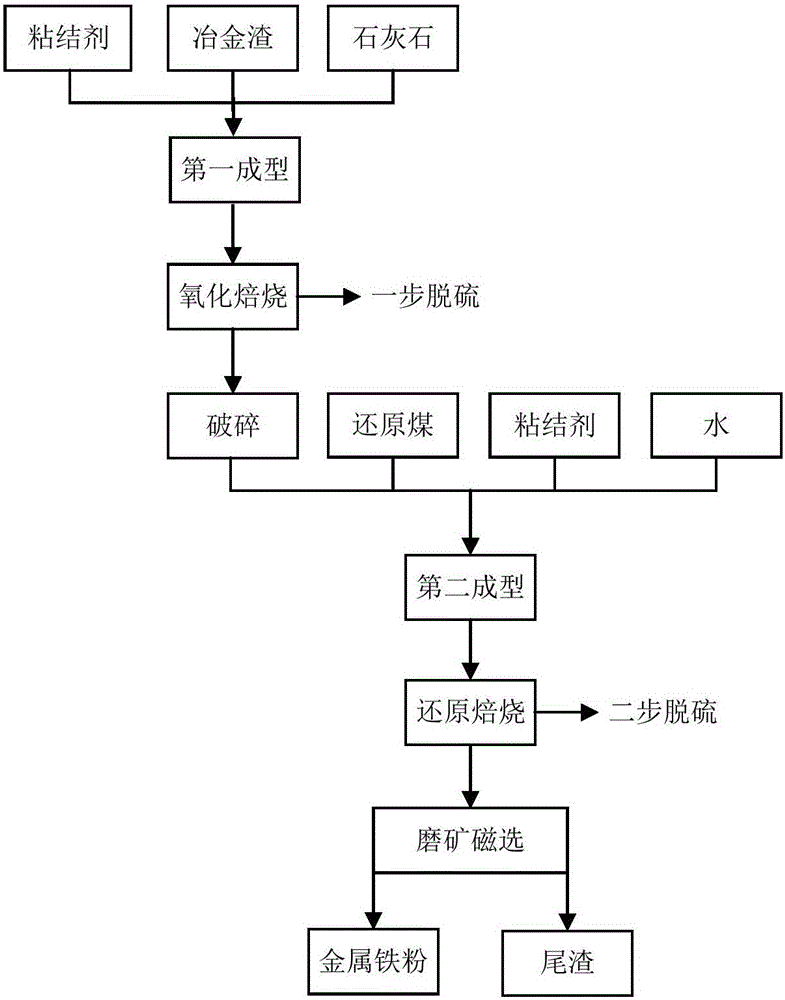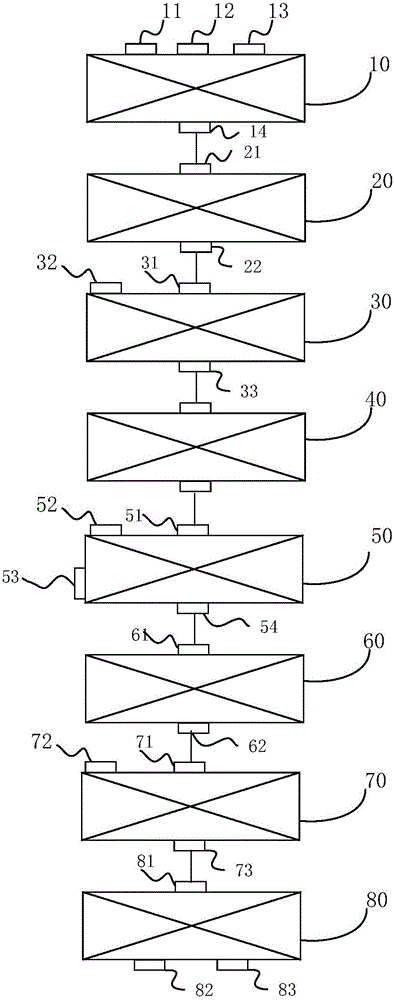Method and system for treating metallurgical slag
A metallurgical slag and oxidative roasting technology, applied in the metallurgical industry, can solve the problems of high energy consumption, incomplete reduction, unfavorable steelmaking process, etc.
- Summary
- Abstract
- Description
- Claims
- Application Information
AI Technical Summary
Problems solved by technology
Method used
Image
Examples
Embodiment 1
[0056] A copper smelting slag, its composition is: TFe 41.52%, Cu 0.36%, S 0.35%. Reduced coal fixes 72% of carbon and 0.32% of S. Mix according to the ratio of copper slag: limestone: binder = 100:18:10, and the mixed material is pelletized. After the pellets are dried, oxidative roasting is carried out at a roasting temperature of 850° C. and a roasting time of 25 minutes. After roasting, the S content of the pellets is 0.02%. The pellets are crushed to below -2mm, and the balls are mixed and pressed according to the ratio of copper slag after roasting: reduced coal: binder: water = 100:25:5:10, and reduction roasting is carried out after the pellets are dried. The roasting temperature is 1200 ℃, and the firing time is 40 minutes. The calcined pellets are cooled by water quenching and then subjected to grinding and magnetic separation to finally obtain metal iron powder with TFe92.89%, and the S content in the iron powder is 0.021%.
Embodiment 2
[0058] A copper smelting slag, its composition is: TFe 41.52%, Cu 0.36%, S 0.35%. Reduced coal fixes 72% of carbon and 0.32% of S. Mix according to the ratio of copper slag: limestone: binder = 100:15:10, and the mixed material is pelletized. After the pellets are dried, oxidative roasting is carried out at a roasting temperature of 850° C. and a roasting time of 25 minutes. After roasting, the S content of the pellets is 0.027%. The pellets are crushed to below -2mm, and the balls are mixed and pressed according to the ratio of copper slag after roasting: reduced coal: binder: water = 100:25:5:10, and reduction roasting is carried out after the pellets are dried. The roasting temperature is 1200 ℃, and the firing time is 40 minutes. The calcined pellets are cooled by water quenching and then subjected to grinding and magnetic separation to finally obtain metal iron powder with TFe92.03%, and the S content in the iron powder is 0.030%.
Embodiment 3
[0060] A copper smelting slag, its composition is: TFe 41.52%, Cu 0.36%, S 0.35%. Reduced coal fixes 72% of carbon and 0.32% of S. Mix according to the ratio of copper slag: limestone: binder = 100:15:10, and the mixed material is pelletized. After the pellets are dried, oxidative roasting is carried out at a roasting temperature of 900° C. and a roasting time of 20 minutes. After roasting, the S content of the pellets is 0.022%. The pellets are broken down to below -2mm, and the balls are mixed and pressed according to the ratio of copper slag after roasting: reduced coal: binder: water = 100:25:5:10, and reduction roasting is carried out after the pellets are dried. The roasting temperature is 1300 ℃, and the firing time is 25 minutes. The calcined pellets are cooled by water quenching and then subjected to grinding and magnetic separation to finally obtain metal iron powder with TFe93.14%, and the S content in the iron powder is 0.021%.
PUM
 Login to View More
Login to View More Abstract
Description
Claims
Application Information
 Login to View More
Login to View More - R&D
- Intellectual Property
- Life Sciences
- Materials
- Tech Scout
- Unparalleled Data Quality
- Higher Quality Content
- 60% Fewer Hallucinations
Browse by: Latest US Patents, China's latest patents, Technical Efficacy Thesaurus, Application Domain, Technology Topic, Popular Technical Reports.
© 2025 PatSnap. All rights reserved.Legal|Privacy policy|Modern Slavery Act Transparency Statement|Sitemap|About US| Contact US: help@patsnap.com


